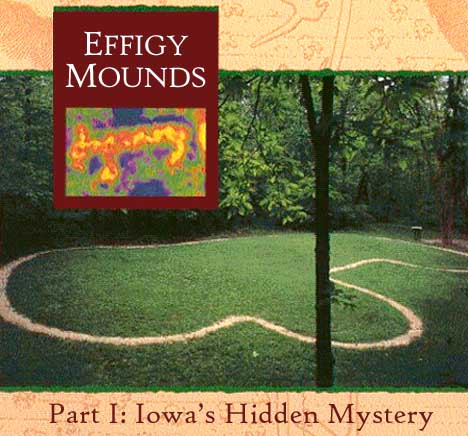
Editorial
|
Fragments
|
Effigy Mounds I
|
Sea Serpents III
|
Atlantis III
Register
for our new Hall of Records Newsletter!
Questions? Comments? Suggestions? Advertising? Press Releases?
Contact us!
Effigy Mounds Part II: The Spirit of the Mounds
The Mystery Begins
|
Effigy Mounds National Monument
|
Uncover the Mystery
Effigy Links
|
Effigy Books
|
Effigy Audio
 idden in the high, rolling hills of northeast Iowa is a mystery veiled from the view of the average tourist, but available to those who
are willing to go the extra mile to seek out one of America's hidden mysteries. Largely unknown to all but the most experienced
archaeologists and historians specializing in North American archaeology and history, the Effigy Mounds represent an as yet unsolved
mystery of America's peculiar past. In Part I of our two part series on Iowa's Effigy Mounds, we will try to uncover some of the
answers behind these ancient enigmas.
idden in the high, rolling hills of northeast Iowa is a mystery veiled from the view of the average tourist, but available to those who
are willing to go the extra mile to seek out one of America's hidden mysteries. Largely unknown to all but the most experienced
archaeologists and historians specializing in North American archaeology and history, the Effigy Mounds represent an as yet unsolved
mystery of America's peculiar past. In Part I of our two part series on Iowa's Effigy Mounds, we will try to uncover some of the
answers behind these ancient enigmas.

The mystery of the Effigy Mounds
began at the end of the last
Ice Age,
some 11,000-13,000 years ago. Over a period of hundreds of thousands of years before that time,
during a period in Earth's ancient history known as the
Pleistocene epoch (2,000,000-9500 b.c.),
glaciers
ruled over most of North America. During this
epoch,
which actually lasted about two million years, these massive, moving continents of snow and ice thousands of feet thick slowly carved out
the beginnings of what would later be known as the Upper Mississippi River Valley. By the end of the last Ice Age, the melting waters of
the glaciers had completed the job, forming what we now know as the headwaters of the Father of Waters — the Mississippi
River.1

|
|

|
|
A Paleo-Indian. These ancient ancestors of our modern Native Americans migrated to North America via the Bering Straits roughly
12,000 years ago, near the end of the last Ice Age.
|
The same glaciers that had carved out the Upper Mississippi River Valley also provided passage for the ancestors of the first Native
Americans to cross over from Asia into North America. These "Paleo-Indians" of the Paleo-Indian Period (9500-7500 b.c.) were likely
following the migrations of such
"megafauna"
as the mastodon, the mammoth, and the giant elk, and the many other large animals typical of the late Pleistocene
|
|

|
|
A "Clovis Point" spearhead typical of the Paleo-Indian Period.
|
that richly provided them with all of their daily needs. Unfortunately, we know little of these ancient peoples, as they were nomadic,
leaving behind little evidence of their existence. As Dennis Lezendorf explains in
Effigy Mounds: A Guide to Effigy Mounds National Monument,
"Knives, bone tools, drills and scrapers have been found, but the archaeological record from the Paleo-Indian Period is sparse in the
Upper Mississippi River Valley."2

During the Archaic Period (7500-500 b.c.), these early Native Americans gradually converted from being primarily nomadic hunter-gatherers
to living communally in fixed campsites. These campsites were usually close to foodsources such as rivers or good hunting grounds, and the
choice of which campsite would be occupied depended on the season and upon the availability of food. However, by the Late Archaic Period
(2500-500 b.c.), early Native Americans began to get involved more in agriculture and trade with neighboring tribes, and started to
develop the first trappings of civilization.
 |
|
|
 |
 |
|
Paleo-Indian Period
|
9500-7500 b.c.
|
|
|
Archaic Period
|
7500-500 b.c.
|
|
|
Early Archaic
|
7500-5500 b.c.
|
|
|
Middle Archaic
|
5500-2500 b.c.
|
|
|
Late Archaic
|
2500-500 b.c.
|
|
|
Woodland Period
|
500 b.c.-1250 a.d.
|
|
|
Early Woodland
|
500-100 b.c.
|
|
|
Middle Woodland
|
100 b.c.-600 a.d.
|
|
Late Woodland
(Effigy Moundbuilders)
|
600-1250 a.d.
|
|
|
Oneota Period
|
1250-1600 b.c.3
|
|
|
|
 |
|
By the end of the Archaic Period (around 500 b.c.), early Native Americans had begun to develop distinct familial and tribal identities,
as well as religious and political systems, as is evidenced by their increasingly elaborate methods of burial. As they began to become
settled in the Upper Mississipi River Valley, these early Native Americans developed beliefs that reflected what they saw around them.
Local wildlife, natural forces, and the great river that provided rich fishing and a means for communication and trade with other
Native Americans all became prominent in their beliefs. As they began to settle into the land and become familiar with its ways, this
collection of scattered, disorganized beliefs gradually grew into an organized belief system. This system explained how the world worked,
including views both of life and of the afterlife.

The Woodland Period
(500 b.c.-1250 a.d.) was a period of unusual stability in the way of life of the Native Americans of the Upper Mississippi River Valley.
Though they would still change camps in fall and winter, moving to rock shelters to protect themselves from the extremes of wind and cold,
they began more and more to take on the trappings of civilization. During the
Woodland Period,
Native Americans began to make significant progress in agricultural development, started staking out good hunting and fishing areas
instead of following migrating herds, and even began to make pottery and engage in trade with neighboring cultures via the Mississippi
River and its tributaries. It was during this time of unusual stability that Native Americans of the Upper Mississippi River Valley
began to become truly civilized and, as a result, they now had the time and resources to invest in such luxuries as developing complex
burial systems for their dead — the very first burial mounds.

Over the nearly 2,000 years of the Woodland Period, Native American burial mounds were built in a variety of shapes and sizes, ranging
from simple, circular shapes to complex "effigy" shapes. These mound types gradually evolved over time, and were used for both burial
and ceremonial purposes.
 Conical Mounds
(500 b.c.-1250 a.d.) Conical Mounds
(500 b.c.-1250 a.d.)
Conical mounds are mounds that are circular in shape. The most common and easiest to build, they once numbered in the thousands,
and could be found scattered throughout the entire Upper Mississippi River Valley. Conical mounds were typically used for burial, but
were likely also used for religious, political and/or familial purposes. Conical mounds were most typical of the Early Woodland Period
(500-100 b.c.), but were of course built throughout the entire Woodland Period (500 b.c.-1250 a.d.).
 Linear Mounds
(100 b.c.-600 a.d.) Linear Mounds
(100 b.c.-600 a.d.)
Linear mounds began to be developed during the Middle Woodland Period (100 b.c.-600 a.d.). Though some literature on the subject
claims that linear mounds were used for burial purposes, Lezendorf disagrees, stating, "Linear mounds were not used for burial but
may have been used to show connections between various groups buried in the conical mounds. With little to no evidence in the linear
pattern, archaeologists have to speculate on their purpose."4 According to Lezendorf,
the linear mounds most likely served to help organize the various conical mounds, perhaps to associate the burial mounds of various
family members. However, it is possible some linear mound burials do exist, still awaiting discovery, so the question of the purpose
of the linear mounds is still open to debate.
 Compound Mounds
(100 b.c.-600 a.d.) Compound Mounds
(100 b.c.-600 a.d.)
Compound mounds are essentially a combination of conical and linear mounds. Compound mounds did contain burials, combining aspects of
conical burial mounds and the apparently organizational function of linear mounds. Assuming that linear mounds were indeed developed to
associate various mounds or mound groups, compound mounds were likely an innovation in mound building design intended to more efficiently
link together the burial mounds of several generations of family members. Compound mounds were thus a logical evolution of mound building
during the Middle Woodland Period.
 Effigy Mounds (600-1250 a.d.) Effigy Mounds (600-1250 a.d.)
Effigy mounds began to appear during the Late Woodland Period (600-1250 a.d.). Effigy mounds were identical in function to conical mounds,
but in form they were far more complex, emulating the shapes of numerous types of animals including but not limited to birds, bear, deer,
bison, lynx, turtles, panthers and/or
"water spirits".5
As was discussed previously, the creation of effigy mounds likely reflected Native American religious beliefs, beliefs in which wildlife
apparently figured prominently. In the area of northeast Iowa that contains Effigy Mounds National Monument, birds
and bears make up all of the known effigy mounds, though effigy mounds of the other listed types can be found in southeastern Minnesota,
southern Wisconsin, and northern Illinois as far as Lake Michigan.

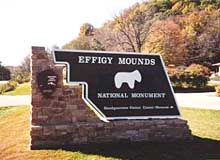 Effigy Mounds National Monument
contains most of the Woodland Period burial mounds remaining in northeast Iowa. Located near Harper's Ferry, Iowa and
Prairie du Chien, Wisconsin on bluffs overlooking the Mississippi River,
Effigy Mounds National Monument
is a very well designed and organized tribute to northeast Iowa's ancient mound builders. Founded in 1949 by Presidential Proclamation,
the park contains 13 miles of trails offering easy access to nearly all of the mounds. It is divided into two main sections:
the "North Unit", and the "South Unit", which are physically separated from each other by the natural barrier of the Yellow River.
Effigy Mounds National Monument
contains most of the Woodland Period burial mounds remaining in northeast Iowa. Located near Harper's Ferry, Iowa and
Prairie du Chien, Wisconsin on bluffs overlooking the Mississippi River,
Effigy Mounds National Monument
is a very well designed and organized tribute to northeast Iowa's ancient mound builders. Founded in 1949 by Presidential Proclamation,
the park contains 13 miles of trails offering easy access to nearly all of the mounds. It is divided into two main sections:
the "North Unit", and the "South Unit", which are physically separated from each other by the natural barrier of the Yellow River.

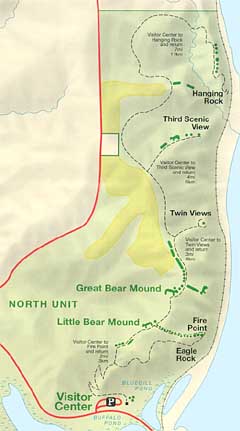
|
The North Unit is the larger of the two divisions, and includes the most mounds and trails. The main trail in the North Unit provides
views of numerous mounds of all types, and several side trails branch off the main trail to afford visitors access to additional mound
groups and several beautiful views of the Mississippi River. These secondary trails include Fire Point Trail Loop, The Twin Views Side
Trail, The Third Scenic View Side Trail, and the Hanging Rock Trail.

As one leaves the Visitor's Center to begin hiking the sylvan beauty of the main trail, they are confronted almost immediately by a group
of three 2,000-year-old mounds only 150 feet from the start of the trail. One of these mounds was found to contain about a dozen bundle
burials, and was also rich in a number of ancient artifacts: "Besides burials, a copper breastplate and shells from the Gulf Coast,
ceremonial obsidian points from the Rocky Mountains, and Knife River flint from North Dakota were found in the
mound."6 A second mound also once contained an altar where cremated bones had been placed
as part of a ritual burial practice common to the Middle Woodland Period. The third mound, unfortunately, was partly destroyed by the
creation of a logging road, but it has since been reconstructed.
The next half-mile of hiking is uphill and fairly difficult, as the majority of the mounds to be found in the monument are located on the
blufftops on the west side of the Mississippi River. After visitors negotiate this zig-zaggy, uphill trail, the ground levels and they are
soon rewarded with a clear view of two compound mounds and, further on, the beautiful "Little Bear" mound.

The Fire Point Trail Loop is the most popular trail as it is the most accessible and the shortest, being only two miles in total
length from the Visitor's Center and back again. The Fire Point Loop Trail actually overlaps the North Unit Trail for much of its early
length, and the Visitor's Center has a nice guide specifically covering the Fire Point Trail and its features. These features, besides
those already described, include:
 Little Bear Mound Little Bear Mound
"Little Bear" mound, now outlined by gravel and small stones for ease of viewing, was built around 1,000 years ago, near the
end of the Woodland Period, during the era of the "Effigy Moundbuilders". The Little Bear Mound is 80 feet long and 40 feet wide, but only
a 2-3 feet tall at it highest point. It contains no burials, but layers of charcoal remnants were found at its heart. This indicates that
the Little Bear Mound was once adorned with ceremonial fires, meaning that it once had important ritual significance.
|
|
|
|
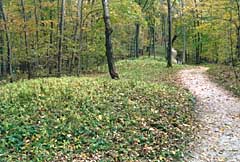
|
|
|
A view of the Fire Point Procession. This string of 19 conical mounds terminates in Fire Point Mound, which overlooks the Mississippi
River.
|
 Fire Point Procession Fire Point Procession
Also known as the Chain of Pearls, the Fire Point Procession is composed of no less than 19 conical mounds in a slightly curved line
extending from the main trail to the bluffs overlooking the river. This procession of nineteen mounds terminates in a larger conical
mound know as the Fire Point Mound.
 Fire Point Mound Fire Point Mound
One of three large mounds overlooking the Mississippi at the end of the Fire Point Procession, Fire Point Mound was found to contain at
least 8 burials, including tools made from bird bones and bear teeth, and a copper breastplate, among other things. The end of Fire Point
also offers majestic views of both the Mississippi River, the Yellow River, and of the South Unit region. Eight miles further south,
Pikes Peak State Park can also be seen, overlooking the confluence of the Wisconsin and Mississippi Rivers.
 Eagle Rock Eagle Rock
The remainder of the loop has many more scenic overlooks, including Eagle Rock, around which remains a small stand of original
prairie, including spiderwort, lead plant, blue-eyed grass, yellow star grass, and flowering spurge.
Just after the Little Bear Mound, the trail branches off to the right (east) towards the river, looping around and returning back to the
North Unit Trail, which is why it is also referred to as the "Fire Point Trail Loop". Coming to the confluence of the end of the Fire Point Loop and the North Unit Trail, turn right to continue on to view the remainder of the
mounds of the North Unit.

Past the Little Bear Mound, the North Unit Trail turns into the Hanging Rock Trail. Completing the Hanging Rock Trail hike will take up
to three hours or more to complete, and there are also several side trails and numerous mounds to be explored,
so be sure to be prepared with food, water, reliable clothing, quality footwear and an early start.
 Great Bear Mound Great Bear Mound
At 138 feet long and 65 feet wide, the Great
Bear Mound is the largest known bear mound in the world. It is also unusual in that it lies on its left side, unlike all of the other
bear mounds in Effigy Mounds National Monument which all lie on their right sides. This mound also has a very low profile, and is more
difficult to see than the Little Bear Mound, though it is certainly more impressive in size, once one discerns its massive proportions.
|
|

|
|
The Great Bear Mound. (Click for a larger image)
|
 "Baby Bear" Mound "Baby Bear" Mound
Continuing down the Hanging Rock Trail, a short walk off to the right of the trail is a large, linear mound that points to another,
smaller bear mound. This bear mound, at 67 feet, is one of the smaller bear effigies in the park, and has affectionately come to be
known as the "Baby Bear" Mound.


 Restored Prairie Area Restored Prairie Area
Further down the trail, the hiker will come into an open prairie area containing a series of conical and linear mounds off to the left,
as well as the remnants of a lynx mound that was destroyed by farming. These mounds are located in a field that is being restored to
its original prairie form through controlled burns, the remnants of the lynx mound becoming briefly visible after each of these burnoffs.

Even further down the North Unit Trail there is another side trail called the Twin Views Side Trail. This trail contains one mound at
the end of the trail, and also overlooks the Mississippi River, with a view of Hanging Rock. Views from this trail are also excellent,
and when conditions are right, bald eagles can be seen swooping down from the cliffs, hunting for fish.

A short walk off the main trail, Third Scenic View contains five more mounds, including a linear mound, a bear effigy, and three conical
mounds. The best view of Hanging Rock can be seen here from here, as well as a good view of the valley below, which was once a large
Woodland Period village.

The remainder of the Hanging Rock trail is fairly arduous, and it should only be taken if time and resources allow. Two linear mounds can
be seen at the midpoint of the trail, which drops down quickly to a ravine, requiring an additional climb up to the far northern hill
which contains Hanging Rock. The trail terminates at Hanging Rock, with a string of 6 conical mounds and a compound mound along the way.

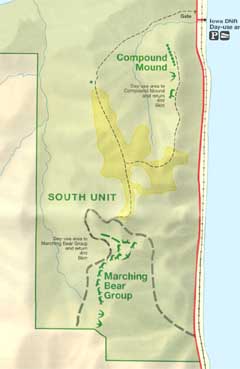
|
The South Unit, though smaller in scale, has perhaps the most spectacular mound groups in the park, if not in the world. It is divided
into two basic areas, the "Compound Mound" and the "Marching Bear Group". The South Unit is a little more remote than is the North Unit.
To reach the South Unit from the Visitor's Center, turn left onto Highway 76 and go about a half mile or so, where you will see a sign
indicating parking and picnicking facilities on the east (river) side of the road. The entrance to the South Unit is on the west side of
the road, so take care as you will need cross Highway 76 to enter.
After negotiating the vehicle barrier, hikers must endure a simple but relatively steep trail that climbs for nearly a mile. On the way
to the main mound groups, off to the right of the trail, the hiker is treated to two linear mounds and a bear effigy mound, unmarked on
the map save for a single green dot. Shortly thereafter, the lush green canopy gives way to open prairie festooned with native
grasses and wildflowers. Thie area is also recovered prairie, maintained by controlled burnings by park personnel, as is the prairie area
in the North Unit. As Lezendorf explains, "Since the late 1980s, the National Park Service has used controlled or prescribed burns to
keep the blackberry, sumac and aspen from overtaking the prairie. Indian grass is the dominant tall grass. Other grasses include big
and little bluestem. Blazing star, yellow coneflowers and various asters add color to the prairie in
August."7

The trail having leveled off, the hiking becomes more pleasant. After a modest walk through the waving grasses, the hiker is confronted
by a fork in the trail. Taking the left fork, the hiker shortly leaves the restored prairie and reenters the forest. About a half-mile's
walk brings one to the Compound Mound Group, composed of three substantial structures:
 Bear Effigy Mound Bear Effigy Mound
The first mound of the Compound Mound group is a large bear effigy. The bear was and is a powerful animal both in the myth (and the
reality) of native American lore, and may have been used as the symbol of a particular family group or clan. This mound is not a burial
mound, but was probably used as part of Native American rituals.
|
|
|
|
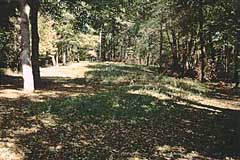
|
|
|
The 212-foot-wide bird effigy, the largest bird effigy in the monument and one of the largest in the world.
Click
here
for a larger version, click
here
for a larger, outlined version.
|
 Bird Effigy Mound Bird Effigy Mound
Following the bear effigy is a spectacular bird effigy. With its 212-foot wingspan, this effigy mound is the largest
bird effigy in the park, and one of the largest in the world. Bird effigies may be intended to represent the
Thunderbird,
another powerful animal of Native American mythology. This mound, like its bear mound partner, likely also had a primarily ritual purpose.
 Compound Mound Compound Mound
Finally, at the end of the trail lies the Compound Mound, a huge, 417-foot mound structure. This mound contains 7 conical mounds connected
by its linear segments. With a view of the river after the leaves have fallen in the autumn, this magnificent structure and its ideal
location were likely reserved for an important clan, its great length likely indicating that the clan was a long-lived one, with many
generations.

Returning back up the path takes one back to the fork. Take a left to proceed on to the park's most famous mound group, the Marching Bear
Group. The path soon ends, merging with an old military road. Built in 1840, the military road was used to carry goods from Fort Crawford,
in what is now Prairie du Chien, to Fort Atkinson to the west, but fell into disuse some time later. It remains as a servicable, if
somewhat rough trail, now serving as the path to the Marching Bear Group at the top of the hill. Near the top of the trail,
after climbing some ways, the military road veers off, and a vast, open canopy beneath and between the outspreading trees reveals a
magnificent avenue of mounds, the like of which cannot be seen anywhere else in the world.
|
|
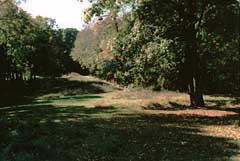
|
|
|
A view of the Marching Bear Group from the north. There are a total of 10 bears in the group, stretching over 1/3 of a mile, two of
which can be viewed here.
Click
here
for a larger version, click
here
for a larger, outlined version.
|
|
The monuments of ancient North America do not compare in glory with the pyramids of Egypt. Not even the massive Monk's Mound at
Cahokia, which rivals in size even the Great Pyramid of Giza,
can be truly said to be an accomplishment that is truly comparable to that of the Great Pyramid. However, even though the monuments of
Egypt and other nations are technically superior and aesthetically more pleasing from classical artistic standards, the subtle, natural
glory of the Marching Bear Group, outspread amidst the lush, green canopy of the North American forest, is quite impressive in its own
right. The scale of the work that went into the building of these mounds, and the thoughtful manner in which they were laid out, is a
marked achievement in the history of Native American culture.
 Walk among the mounds and savor the history of the American Midwest. Effigy Mounds National Monument offers a rare mixture of ancient
history and natural beauty that makes for an excellent day trip. Visit during the summer to see the prairie flowers in full bloom, or
during the fall to see the explosion of colors in the rich forests of northeastern Iowa. Come for the sightseeing, or just for the
exercise. Pets are also allowed, and picnicking facilities are available year-round, so the Monument is also an inexpensive and satisfying
family trip destination.
Walk among the mounds and savor the history of the American Midwest. Effigy Mounds National Monument offers a rare mixture of ancient
history and natural beauty that makes for an excellent day trip. Visit during the summer to see the prairie flowers in full bloom, or
during the fall to see the explosion of colors in the rich forests of northeastern Iowa. Come for the sightseeing, or just for the
exercise. Pets are also allowed, and picnicking facilities are available year-round, so the Monument is also an inexpensive and satisfying
family trip destination.

Effigy Mounds National Park is relatively remote, located in the tiny town of Harper's Ferry, Iowa, three miles north of Marquette,
Iowa and six miles northwest of Prairie du Chien, Wisconsin. Highway 76 is the best method for traveling through this area, as shown
on the maps below:
 Map of northeast Iowa
Map of northeast Iowa
 Map of Marquette, Iowa
Map of Marquette, Iowa
 Map of Effigy Mounds National Monument
Map of Effigy Mounds National Monument
There are also regional airports in La Crosse (70 miles) and Madison (120 miles), WI; and Dubuque (70 miles) and Cedar Rapids (120 miles),
IA. There is no public transportation available.

Effigy Mounds is open daily 8:00 a.m. to 4:30 p.m. with extended hours Memorial Day to Labor Day and weekends in October. The monument is
closed Thanksgiving Day, Christmas Day, and New Year's Day. The Visitor's Center contains interesting and informative displays, a very
good diorama detailing the layout of the mounds, and a nice gift shop with many books and gifts of historical interest. The Museum
in the Visitor's Center is open all year 8:00 a.m. to 4:30 p.m. - extended hours in summer. Phone: 563-873-3491. The Visitor
Center, museum, book sales outlet and auditorium are accessible to wheelchairs. Consult rangers at information desk for access to the
hiking trails.

For more information, contact the
Effigy Mounds National Monument
at 151 HWY 76, Harpers Ferry, IA 52146-7519; phone: 563-873-3491; fax: 563-873-3743; email:
efmo_superintendent@nps.gov.
The best, nearest
lodging
and
dining
is in Prairie du Chien, Wisconsin. Consult the
Prairie du Chien Chamber of Commerce website,
call 1-800-732-1673, or email
info@prairieduchien.org
for more information.




















Editorial
|
Fragments
|
Effigy Mounds I
|
Sea Serpents III
|
Atlantis III
Register
for our new Hall of Records Newsletter!
Questions? Comments? Suggestions? Advertising? Press Releases?
Contact us!

1
Dennis Lezendorf,
Effigy Mounds: A Guide to Effigy Mounds National Monument
(Fort Washington, PA: Eastern National, 2000), 5.
2
Lezendorf,
Effigy Mounds, 9.
3
Table adapted from
Effigy Mounds, 8.
4
Lezendorf,
Effigy Mounds, 21.
5
Lezendorf,
Effigy Mounds, 21.
6
Lezendorf,
Effigy Mounds, 101.
7
Lezendorf,
Effigy Mounds, 112.


 National Park Service: Effigy Mounds National Monument
National Park Service: Effigy Mounds National Monument
 National Park Service: The Monument
National Park Service: The Monument
 National Park Service: Printable Travel Guide
National Park Service: Printable Travel Guide
 Effigy Mounds Area Current Events
Effigy Mounds Area Current Events
 eparks.com: Effigy Mounds National Monument Bookstore
eparks.com: Effigy Mounds National Monument Bookstore
 Effigy Mounds National Monument Online Teachers' Guide
Effigy Mounds National Monument Online Teachers' Guide
 National Scenic Byways Program: Effigy Mounds National Monument
National Scenic Byways Program: Effigy Mounds National Monument
 L.L. Bean: Park SearchSM Effigy Mounds National Monument
L.L. Bean: Park SearchSM Effigy Mounds National Monument
 GORP: Effigy Mounds National Monument
GORP: Effigy Mounds National Monument
 National Register of Historic Places: Effigy Mounds National Monument
National Register of Historic Places: Effigy Mounds National Monument

 Far Shores: New Investigation Into Ancient Indian Effigy Mounds
Far Shores: New Investigation Into Ancient Indian Effigy Mounds
 University of Iowa Office of the State Archaeologist
University of Iowa Office of the State Archaeologist
 The Comparative Archaeology Web: Mounds, Monuments, and the Politics of Power: Dimensions of Effigy Mound Function
The Comparative Archaeology Web: Mounds, Monuments, and the Politics of Power: Dimensions of Effigy Mound Function
 Spirits Made of Earth: The Effigy Mounds - Ho-Chunk Connection Revisited
Spirits Made of Earth: The Effigy Mounds - Ho-Chunk Connection Revisited
 Sorceryn: Earthworks - "Spirits Made of Earth: The Effigy Mounds"
Sorceryn: Earthworks - "Spirits Made of Earth: The Effigy Mounds"
 Beloit College: Woodland Museum: The Woodland Tradition
Beloit College: Woodland Museum: The Woodland Tradition
 Minnesota State University eMuseum: Effigy Mound Building
Minnesota State University eMuseum: Effigy Mound Building
 High Road to Salvage Archaeology: Effigy Mound Culture
High Road to Salvage Archaeology: Effigy Mound Culture
 Mound and Effigy Mound Cultures Discussion Group
Mound and Effigy Mound Cultures Discussion Group
 Society for American Archaeology
Society for American Archaeology
 Mississippian Figurines
Mississippian Figurines
 NativeWeb
NativeWeb

 Prairie du Chien Chamber of Commerce
Prairie du Chien Chamber of Commerce
 Prairie du Chien Restaurants
Prairie du Chien Restaurants
 Prairie du Chien Lodging
Prairie du Chien Lodging
 Expedia: Lodging in Prairie du Chien, Wisconsin
Expedia: Lodging in Prairie du Chien, Wisconsin
 Prairie du Chien Area Guide
Prairie du Chien Area Guide
 WisTravel.com: Prairie du Chien
WisTravel.com: Prairie du Chien
 RiverRoads.com: Prairie du Chien and Bridgeport, Wisconsin
RiverRoads.com: Prairie du Chien and Bridgeport, Wisconsin
 Map: Prairie du Chien
Map: Prairie du Chien
 Prairie Dog Blues Festival
Prairie Dog Blues Festival
 The Natural Gait
The Natural Gait


 Effigy Mounds: A Guide to Effigy Mounds National Monument
Effigy Mounds: A Guide to Effigy Mounds National Monument
Robert A. Birmingham, Leslie E. Eisenberg
Rating:
   
This handy guide tells you everything you need to know about Effigy Mounds National Monument. If you need to find something out about the park, this is the book for you. Available from the Effigy Mounds National Monument bookstore, or from eparks.com. Softcover, 120 pages.
(Review by eparks.com)
Click
here
to buy this book.
 Exploring Iowa's Past: A Guide to Prehistoric Archaeology
Exploring Iowa's Past: A Guide to Prehistoric Archaeology
Lynn Marie
Distilling information from hundreds of archaeological studies, Lynn Marie builds a fascinating story of thirteen thousand years of
human achievement, adaptability, resilience, interaction, and survival. This book is indispensable for archaeologists, historians,
educators, and everyone interested in the native peoples of Iowa and surrounding regions. (Review by William Green, State Archaeologist
of Iowa)
Click
here
to buy this book.
 Indian Mounds of Wisconsin
Indian Mounds of Wisconsin
Robert A. Birmingham, Leslie E. Eisenberg
Throughout history, the mound-builder societies of the many Native American cultures have captured many people's attention. The indigenous mound-building society in Wisconsin, known as the Ho-Chunk, or Winnebago, and the Ioway people were two of the most prolific in the U.S. Because of the increased requests for information, Birmingham and Eisenberg have completed one of the most comprehensive guides to the mounds of Wisconsin. Previously, none of the information on the mounds or their builders was available in a complete volume. Beginning with Wisconsin's early occupants, this work details 2,000 years of history, from pre-mound-builder groups to the modern era. Throughout the book, there are photographs, maps, and detailed drawings of artifacts, people, and the mounds. Included in the appendix is a listing of mound sites open to the public. Indian Mounds is an important and necessary addition to any collection on Native American cultures and the early history of the Midwest. (Review by Amazon.com)
Click
here
to buy this book.
 Indian Mounds of the Middle Ohio Valley: A Guide to Mounds and Earthworks of the Adena, Hopewell, Cole, and Fort Ancient People
Indian Mounds of the Middle Ohio Valley: A Guide to Mounds and Earthworks of the Adena, Hopewell, Cole, and Fort Ancient People
Susan L. Woodward, Jerry N. McDonald
Rating:
   
Throughout history, the mound-builder societies of the many Native American cultures have captured many people's attention. The indigenous mound-building society in Wisconsin, known as the Ho-Chunk, or Winnebago, and the Ioway people were two of the most prolific in the U.S. Because of the increased requests for information, Birmingham and Eisenberg have completed one of the most comprehensive guides to the mounds of Wisconsin. Previously, none of the information on the mounds or their builders was available in a complete volume. Beginning with Wisconsin's early occupants, this work details 2,000 years of history, from pre-mound-builder groups to the modern era. Throughout the book, there are photographs, maps, and detailed drawings of artifacts, people, and the mounds. Included in the appendix is a listing of mound sites open to the public. Indian Mounds is an important and necessary addition to any collection on Native American cultures and the early history of the Midwest. (Review by Amazon.com)
Click
here
to buy this book.
 The Mound Builders
The Mound Builders
Robert Silverberg
"Our forebears, finding large, incomprehensible earthworks scattered down the Mississippi Valley, refused to believe they were built by the aborigines who still cluttered up the place and impeded settlement. Mr. Silverberg describes, with gleeful and copious quotation, the nineteenth-century literature of speculation which attributed these monuments to Phoenicians, stray Vikings, the lost tribes of Israel, refugees from Atlantis, an extinct race of giants, and Welshmen. The book, which is charmingly written, ends with a history of the archaeological work which gave the mounds back to the Indians." (Review by The Atlantic Monthly)
Click
here
to buy this book.
Mound Builders of Ancient America: The Archaeology of a Myth
Robert Silverberg
Click
here
to buy this book.
 The Eagle's Voice: Tales Told by Indian Effigy Mounds
The Eagle's Voice: Tales Told by Indian Effigy Mounds
Gary J. Maier
Gary Maier's The Eagle's Voice: Tales Told By Indian Effigy Mounds is a kind of anthropological detective story based on Maier's research involving a group of about fifty Indian effigy and conical mounts located on the north shore of Lake Mendota, in Madison, Wisconsin. In his explorations Maier developed a new understanding and insight into these structures which had fascinated and puzzled Europeans and Americans from the 1830s down to the present day. Exceptionally "reader friendly", The Eagle's Voice is enthusiastically recommended reading for the non-specialist general reader with an interest in Native American culture in general, and the effigy mounds of Wisconsin in particular. (Review by Amazon.com)
Click
here
to buy this book.
Under Your Feet: The Story of the American Mound Builders
Blanche King
Through archaeological examinations of the mounds of the Mississippi River Valley, Blanche Busey King reconstructs the lives of the prehistoric inhabitants of that region who built these mounds. Chapters are dedicated to the various objects discovered in the mounds, including clothing, fetishes, flints, copper and bone implements, and many of the artifacts are illustrated by photographs included in the text. King also briefly compares the American Mound Builders to the prehistoric inhabitants of Europe.
Click
here
to buy this book.
The Effigy Mound Culture of Wisconsin
Chandler W. Rowe
Click
here
to buy this book.
Effigy Mounds: Monuments of the Earth
Ellen Osterhaus
Click
here
to buy this book.
 The American Woodland Indians
The American Woodland Indians
Michael G. Johnson, Richard Hook (Illustrator)
The Woodland cultural areas of the eastern half of America has been the most important in shaping its history.
This volume details the history, culture and conflicts of the 'Woodland' Indians, a name assigned to all the
tribes living east of the Mississippi River between the Gulf of Mexico and James Bay, including the Siouans,
Iroquians, and Algonkians. In at least three major battles between Indian and Euro-American military forces
more soldiers were killed than at the battle of Little Bighorn in 1876, when George Custer lost his command.
With the aid of numerous illustrations and photographs, including eight full page colour plates by Richard Hook,
this title explores the history and culture of the American Woodland Indians.
Click
here
to buy this book.

 Serpent Mound
Serpent Mound
Rusty Crutcher
Rating:
   
Evocative music and traditional chants evoke the powerful mystery of the Great Serpent Mound, the first century BC, quarter-mile long Native American animal effigy in southern Ohio. Piano, keyboard, Lakota flute, ocarina and exotic hand percussion subtle blend with on-site environmental recordings. Chants by Jaccarilla Apache Matthew Andrae honor this oldest and largest surviving raised-earth mound in North America. (Review by Amazon.com)
Click
here
to buy this CD.
 Koyaanisqatsi
Koyaanisqatsi
Philip Glass
Rating:
   
Fifteen years after its initial release, Philip Glass's score to Godfrey Reggio's film Koyaanisqatsi is still as timeless as it was
meant to be. Glass's epic score, virtually the only sound in this non-narrative movie, accompanied an exhilarating, wordless meditation
of images ranging from expansive, slow-motion landscapes to whirling-dervish city scenes shot using time-lapse techniques. Glass's music
was a perfect match. The opening chant is still unlike anything Glass has composed, a Tibetan monk operatic growl that set up the
foreboding sense of loss the film engenders. Most of the score, however, casts Glass's minimalist themes in orchestral expanses.
Bass strings troll the bottom while flutes draw circles in the air. On "The Grid," manic keyboards drive into the night, pounding
out the cyclical refrains that are a Glass trademark. When Koyaanisqatsi came out, it seemed opulent with its orchestral forces,
but always at the center were the keyboards, reeds, and voice that are Glass's characteristic sound. Koyaanisqatsi means
"life out of balance," but Glass's remarkably austere score remains perfectly poised. This newly re-recorded edition adds nearly 30
minutes to the previous CD release with two previously unissued tracks and extended versions of "The Grid" and "Prophecies," the two
signpost works of the film. (Review by Amazon.com about the
1998 re-recording
of this album)
Click
here
to buy this CD, or
here
to buy the 1998 re-recording.
Editorial
|
Fragments
|
Effigy Mounds I
|
Sea Serpents III
|
Atlantis III
Register
for our new Hall of Records Newsletter!
Questions? Comments? Suggestions? Advertising? Press Releases?
Contact us!
|

